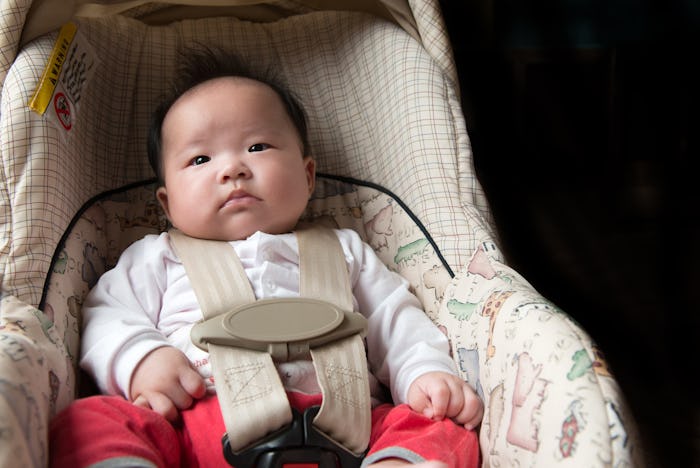Life

9 Car Seat Rules That Could Save Your Baby's Life
You take every precaution to make sure your baby is protected from danger, so familiarizing yourself with car seat rules that could save your baby's life will empower you feel confident your little one is safe while cruising around town with you. Choosing the right seat, installing it properly, and knowing which position your child should be facing are a few of the important safety rules for kids riding in car seats. Since September 18 through 24 is Child Passenger Safety Week, it's the perfect time to brush up on everything you need to know about car seats and proper use.
Whether you are brand new to the car seat game or just need to brush up after having another baby, abiding by these rules will let you know you did everything possible to protect your baby from harm. If you install your car seat and want to make sure you did everything right, find a location near you for National Seat Check Saturday, which is part of Child Passenger Safety Week, and will be on September 24, this year. But don't sweat it if you miss that date. There are certified checkers in almost every city that are happy to help, year round.
Skip the stress when it comes to car seat safety, and go by these nine rules to help keep your precious cargo safe.
1Follow Directions
Car seats can be installed two different ways, with latches or seat belts, according to the website for Healthy Children. Proper installation is the cornerstone of safety for your little one, so don't wing it. Follow the directions exactly and double check the car seat is secure once fully installed.
2Check Your State's Guidelines
Depending on where you live, the safety guidelines for car seats can vary. To make sure you are following your state's car seat rules, check the list on AAA's website, which lists each state and their corresponding laws.
3Keep Size In Mind
With so many options for car seats these days, it's important to know what's right for your child. As the website for Parents Central pointed out, you should choose a car seat based on your child's age and size. Use the chart on Parents Central's site to see what type of seat your child needs to stay safe.
4Stay Rear-Facing As Long As Possible
Research has shown that "children under age two are 75 percent less likely to die or to be severely injured in a crash if they are rear-facing," as Parents magazine reported. The most recent recommendation is to keep kids rear-facing until they reach age two, or grow past the height and weight limits for that seat.
5Keep Them To The Back Seat
Car seats were not meant to find up front, so make sure to always install them in the back seat. As the website for Kid's Health reported, passenger side airbags in the front seats are extremely dangerous to babies and small children, which is why car seats should not be placed there.
6Stick To The Middle
The back seat is best for baby, but to keep your baby as safe as possible, pick the middle. According to the Center for Disease Control and Prevention, you should "buckle children in the middle of the back seat when possible, because it is the safest spot in the vehicle."
7Be Slow To Change
Even as your child grows, be slow to change your car seat. As Safe Kids Worldwide reminded, don't rush to move your child into a new car seat or booster, wait until she has exceeded the height and weight limits.
8Position The Harness Correctly
It's important to do a safety check on the car seat once your child is sitting in it. Once your little one is strapped in, make sure the harness is snug and the clip is placed in the center of her chest, as Healthy Children recommended.
9Remember That Age Is Just A Number
Even though the American Academy of Pediatrics suggests keeping babies in a rear-facing position until age two, there is an exception to this rule. As Parents pointed out, if your child does not meet the size requirements for front-facing seats, keep them facing backwards. It's safer to go by a child's size than their age.